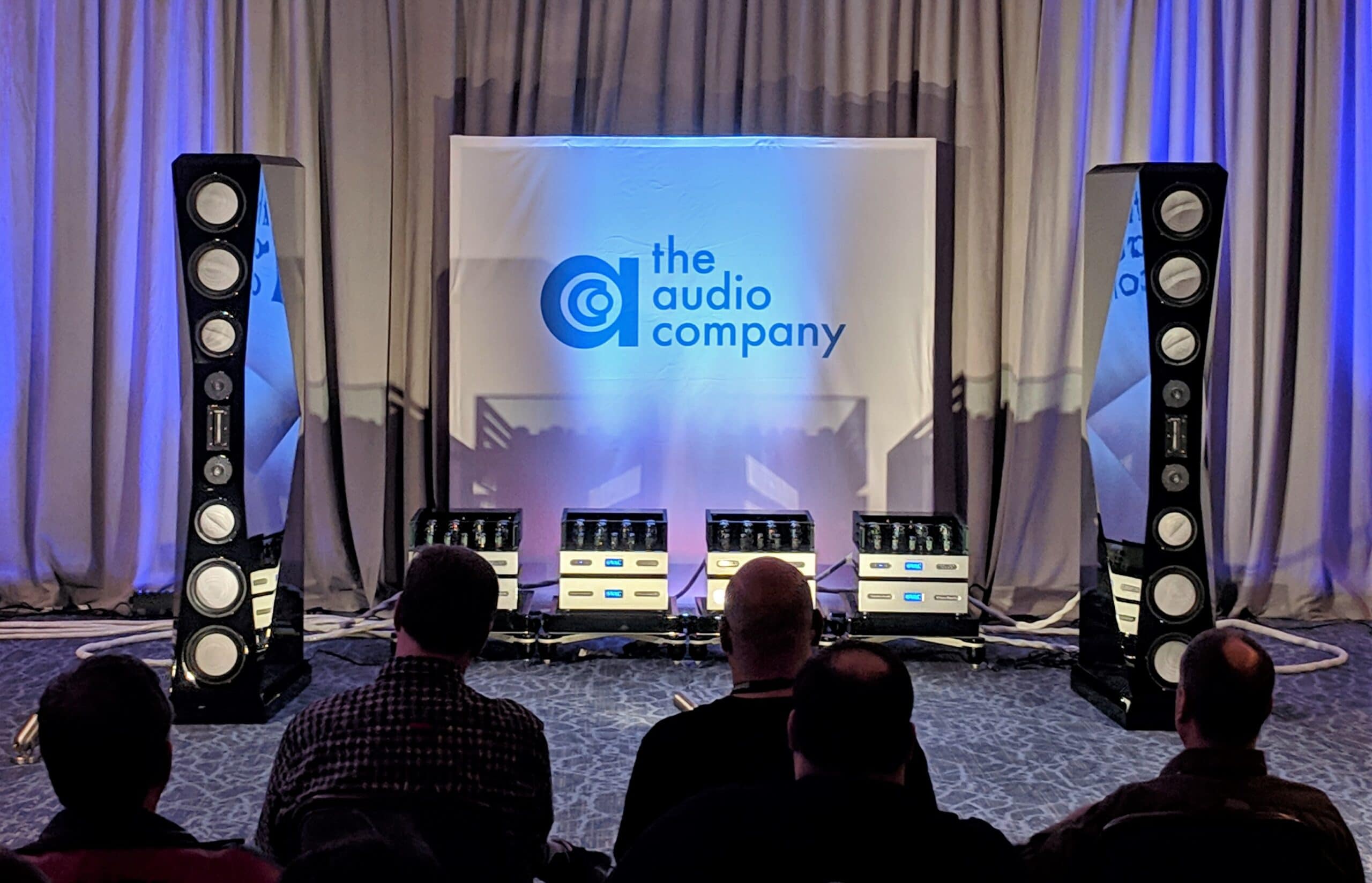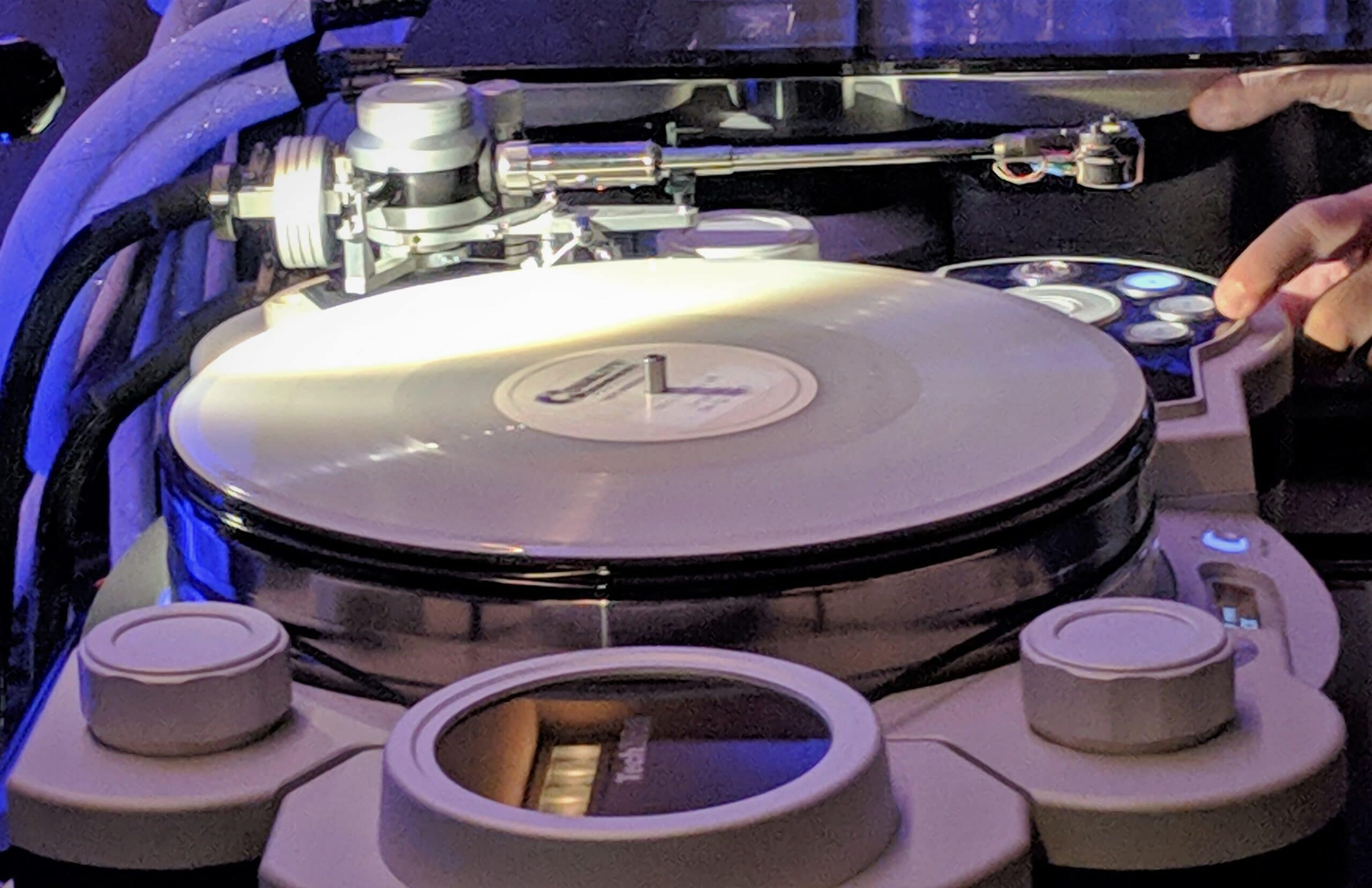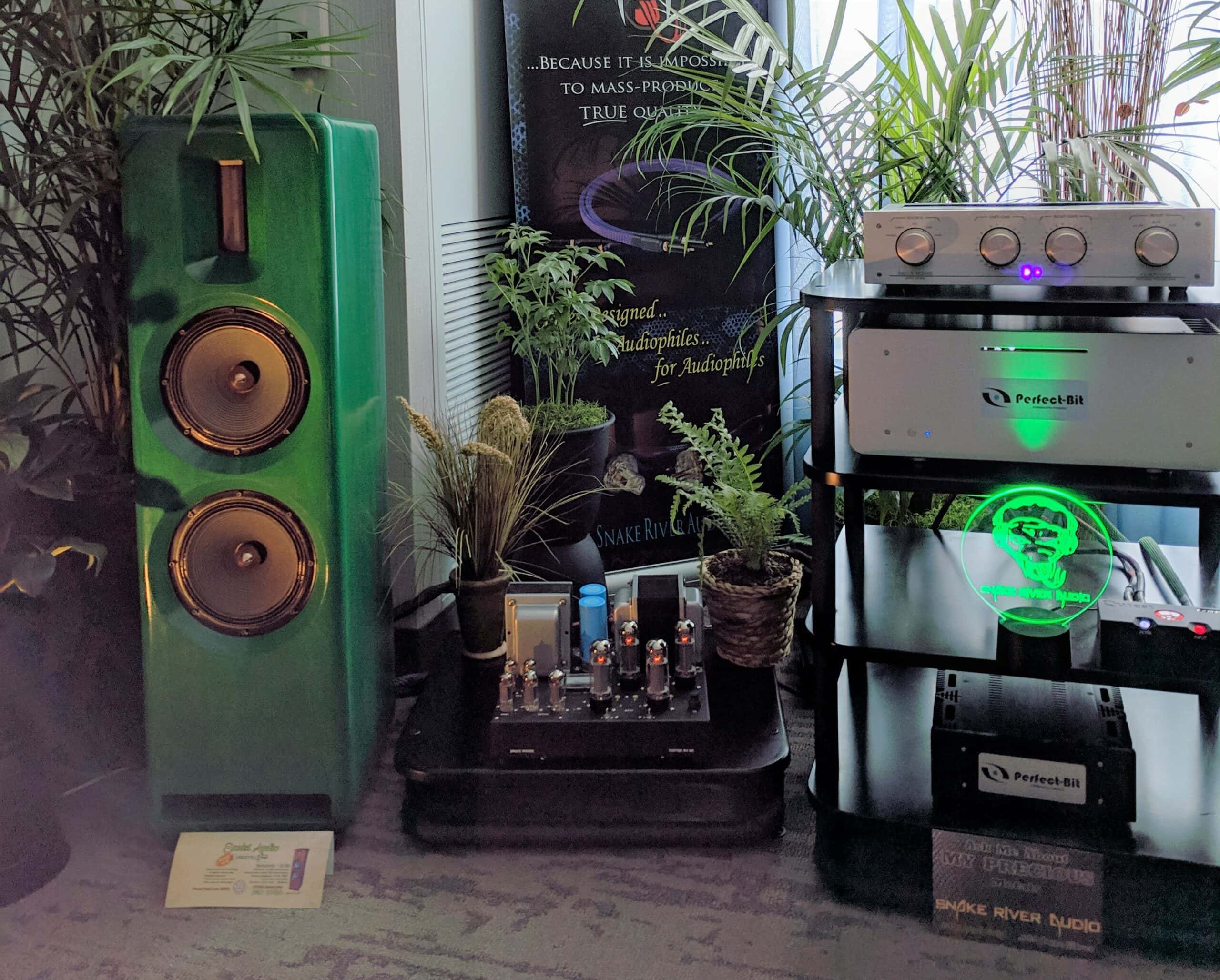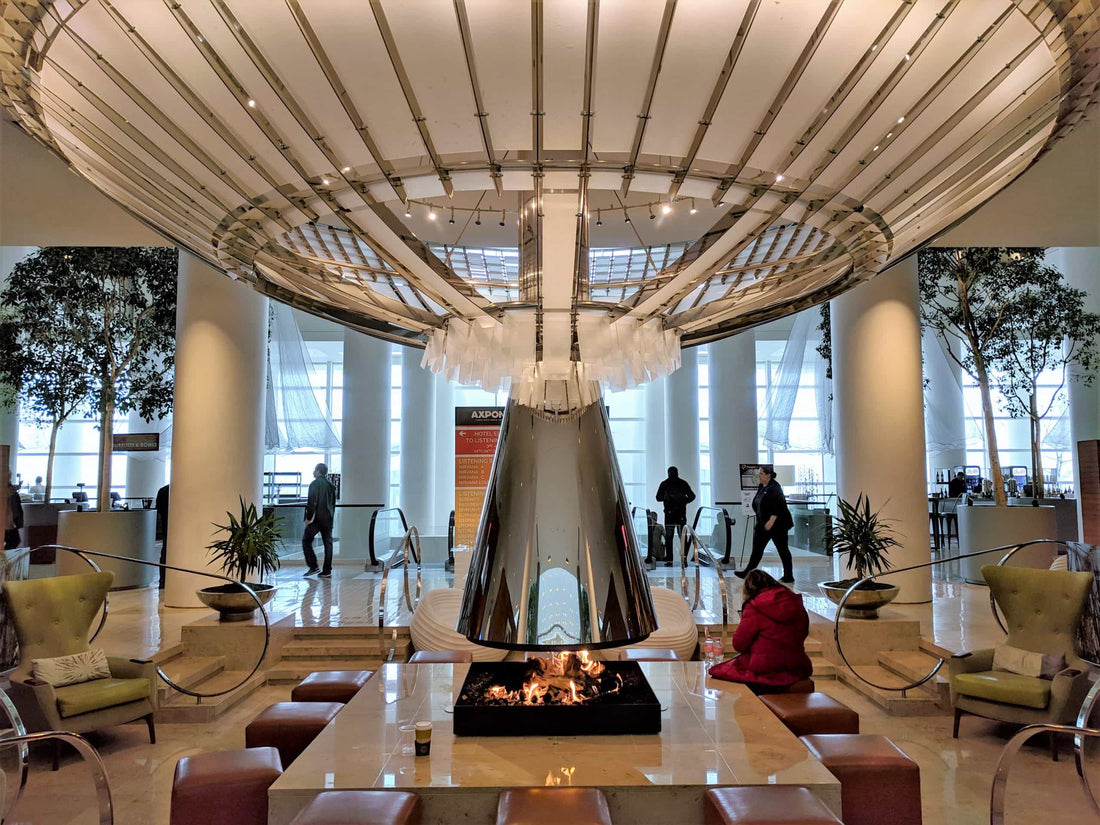Mid-April in Chicago once again presents us with Axpona, one of the largest audiophile shows in North America. Weather was once again an unwelcome participant in this year’s show. Various parts of a major winter storm chased some manufacturers and visitors from west to east, treated us to a final blast of winter on Sunday with at least four inches of wet and blowing snow, and left a wake of slush and a couple dozen cars spun off into the ditches to keep some of us entertained while driving back east at the show’s conclusion.
Inside the Renaissance Schaumburg Convention Center, however, the warmth of electronics, overpriced concession food, and a bit of hot air in a few of the rooms (it is the “windy city,” after all) kept the chill away. The show has grown since last year, occupying the bottom six floors and four top floors at the hotel. It is a lot to cover!
That said, we are given only three days to take in over 180 rooms spread across ten floors of the convention center, not to mention visiting the marketplace and catching seminars, presentations, and this year’s new addition of “flash DJ” sessions by a couple of industry folks. I was rather selective in what I visited this time, choosing to take in the show at a more leisurely pace than scrambling to see every room possible, and spending quality time speaking with a handful of manufacturers and retailers.
If we had to choose a victor in the “streaming wars” based on presence alone, Qobuz brought their A-game and handily won the game, set and match. Aside from sponsoring most floors of the convention center, Qobuz’s audiophile evangelist David Solomon paid a visit to a handful of rooms with a flash DJ session, featuring tracks from the Qobuz Now! playlist. Solomon made it clear that Qobuz are a team of music enthusiasts first and foremost, and his enthusiasm was infectious. He also confirmed that many visitors were informing him that Qobuz sounded better than Tidal. Here is Solomon in the Legacy Audio room:
 The Marketplace and the Ear Gear Expo were back this year in the main hall, with an added concessions area to provide us with an additional dining option. The usual vendor turnout included Acoustic Sounds, Morrow Audio, Music Direct, Elusive Disk, SOTA (the turntable manufacturer), GIK Acoustics, and many, many others. Record cleaning was in abundance this year, with most (or all?) of them selling ultrasonic cleaning systems. I even ran into a fellow Copper contributor, a friendly chap named Roy Hall, presenting his Music Hall turntables to the attendees. Here’s a view facing the Acoustic Sounds setup:
The Marketplace and the Ear Gear Expo were back this year in the main hall, with an added concessions area to provide us with an additional dining option. The usual vendor turnout included Acoustic Sounds, Morrow Audio, Music Direct, Elusive Disk, SOTA (the turntable manufacturer), GIK Acoustics, and many, many others. Record cleaning was in abundance this year, with most (or all?) of them selling ultrasonic cleaning systems. I even ran into a fellow Copper contributor, a friendly chap named Roy Hall, presenting his Music Hall turntables to the attendees. Here’s a view facing the Acoustic Sounds setup:  The Ear Gear Expo was also quite busy. I had a brief conversation with Josh Meredith of Cardas. Despite all the high-end cables Cardas offers, and their pair of earbuds, one of the items they were asked about most often at their booth was Cardas solder. The headphone community has a lot of do-it-yourselfers, and visitors are interested in Cardas solder and other components like their line of audio connectors.
The Ear Gear Expo was also quite busy. I had a brief conversation with Josh Meredith of Cardas. Despite all the high-end cables Cardas offers, and their pair of earbuds, one of the items they were asked about most often at their booth was Cardas solder. The headphone community has a lot of do-it-yourselfers, and visitors are interested in Cardas solder and other components like their line of audio connectors.

The HiFi Man headphone booth was always busy.
The current iteration of Western Electric made a big appearance at the show this year, taking over a small suite with their line of components and a celebration of the 80th anniversary of the legendary 300B vacuum tube. Below are some samples of what they brought to the show, some sporting a variation on a retro industrial style.



CD reproducer
KEF offered us their flagship Muon speaker system, which dwarfed the show attendees. Despite the size, I found the music to have a rather “polite” presentation to it, although I was only able to listen to a few songs in the room. Alongside the chromed Muon pair are the Reference series R11 speakers, not connected during my visits to the room, but they win my award for coolest driver color of the show.
 While we are on the topic of supersized speakers, let’s take a visit to the “million-dollar” room presented by The Audio Company, where the Von Schweikert Ultra 11s, powered by VAC amplifiers, dominated the room. These, quite simply, were the most effortless large speakers I heard at the show, able to convey the full dynamic range and scale of a full orchestra (and capture the lowest notes on the organ), while also treating smaller scale recordings appropriately (no “seven-foot-tall” cellists, in other words). A friend texted me one single word as he sat in the room: “Wow”. None of us mere mortals can afford it, but it’s nice to be able to experience these systems once a year.
While we are on the topic of supersized speakers, let’s take a visit to the “million-dollar” room presented by The Audio Company, where the Von Schweikert Ultra 11s, powered by VAC amplifiers, dominated the room. These, quite simply, were the most effortless large speakers I heard at the show, able to convey the full dynamic range and scale of a full orchestra (and capture the lowest notes on the organ), while also treating smaller scale recordings appropriately (no “seven-foot-tall” cellists, in other words). A friend texted me one single word as he sat in the room: “Wow”. None of us mere mortals can afford it, but it’s nice to be able to experience these systems once a year.  The room was also host to another flash DJ session by none other than Michael Fremer, bringing along some rarities from his vinyl collection to share with us, played on the Air Force One turntable.
The room was also host to another flash DJ session by none other than Michael Fremer, bringing along some rarities from his vinyl collection to share with us, played on the Air Force One turntable.  Fans of The Who’s Who’s Next were treated to an unreleased Analogue Productions 45 RPM test pressing of this title, mastered by Chris Bellman and pressed by QRP. Take a look now, as it’s possible we may never see this one released.
Fans of The Who’s Who’s Next were treated to an unreleased Analogue Productions 45 RPM test pressing of this title, mastered by Chris Bellman and pressed by QRP. Take a look now, as it’s possible we may never see this one released.  I gave the Clearaudio Innovation Basic with TT5 tonearm a wistful look as I paused to grab a picture. One of these days!
I gave the Clearaudio Innovation Basic with TT5 tonearm a wistful look as I paused to grab a picture. One of these days!  Hana’s moving coil cartridges have been known for an impressive bang for the buck, and their newly added flagship “M” series features a nude Microline stylus tip in both high (MH) and low (ML) variations. I heard the ML in Needle Doctor’s room, which sounded as good as the other models I’ve heard in years past—smooth and musical, with no hint of harshness.
Hana’s moving coil cartridges have been known for an impressive bang for the buck, and their newly added flagship “M” series features a nude Microline stylus tip in both high (MH) and low (ML) variations. I heard the ML in Needle Doctor’s room, which sounded as good as the other models I’ve heard in years past—smooth and musical, with no hint of harshness.  One system that has always impressed is the room offered up by Snake River Audio, and the Sonist Concerto 4 loudspeakers did not disappoint. The new version of these speakers sounded even better this year, very musical and extending deeper than I remember them. These are a high-efficiency design that works well with lower-powered tube amplifiers, and avoids the drawbacks of horn-loaded loudspeakers. Houseplants extra.
One system that has always impressed is the room offered up by Snake River Audio, and the Sonist Concerto 4 loudspeakers did not disappoint. The new version of these speakers sounded even better this year, very musical and extending deeper than I remember them. These are a high-efficiency design that works well with lower-powered tube amplifiers, and avoids the drawbacks of horn-loaded loudspeakers. Houseplants extra.  Electrostatic designs have been known for speed and tonal accuracy, as well as requiring that listeners sit in a very small sweet spot. Curved panels help with that aspect, but Muraudio’s take on the electrostatic transducer is unique in that The SP1, shown here, has a 120° horizontal dispersion and covers a much wider sweet spot. More expensive models (not at the show) offer three of the 120° panels to create a 360° omnidirectional sound source. I was not able to audition this at length, but what I heard initially was very promising. I will revisit these at length during next year’s show.
Electrostatic designs have been known for speed and tonal accuracy, as well as requiring that listeners sit in a very small sweet spot. Curved panels help with that aspect, but Muraudio’s take on the electrostatic transducer is unique in that The SP1, shown here, has a 120° horizontal dispersion and covers a much wider sweet spot. More expensive models (not at the show) offer three of the 120° panels to create a 360° omnidirectional sound source. I was not able to audition this at length, but what I heard initially was very promising. I will revisit these at length during next year’s show. 



